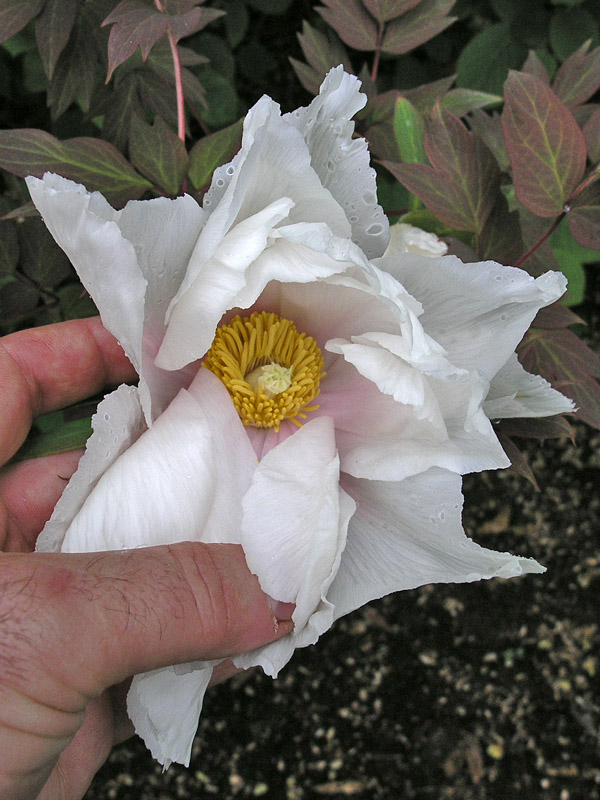
Woody > Paeonia > Paeonia suffruticosa > Paeonia suffruticosa
Paeonia suffruticosa
Mountain or Tree Peony
Origin: Native of Gansu, northern Sichuan and Shaanxi provinces of China.
Mike's
Opinion


"
Paeonia suffruticosa has been around for centuries, a real testament of time, as it has evolved into a real show piece, along with the many stunning cultivars . It can surely be appreciated for its large beautiful blooms in an array of colours in the spring and shapely green fresh foliage in the summer.
Michael Pascoe, NDP., ODH., CLT., MSc. (Plant Conservation)
"
| Family |
| Paeoniaceae |
| Genus |
| Paeonia |
| Species |
| suffruticosa |
| Category |
| Woody |
| Type |
| Shrub (deciduous) |
| USDA Hardiness Zone |
| 4 - 8 |
| Canadian Hardiness Zone |
| 3 |
| RHS Hardiness Zone |
| H7 |
| Height |
| 2 - 2.5 m |
| Spread |
| 1.5 - 2 m |
Photographs
Description and Growing Information
Flowering Period
| General Description |
| Paeonia suffruticosa is a medium-sized deciduous shrub, and has dark green foliage that changes little through the growing season. In late spring, distinct and plentiful flowers begin to bloom in colours such as white, yellow, pink, red, and even purples depending on cultivar choice or selection. |
| Landscape |
| Historically Paeonia suffruticosa was cultivated mainly for its many medicinal properties, but then it was also recognized for having a wonderful ornamental value. It can be used as an accent piece, with its beautiful ornate flowers and green foliage that stay crisp throughout the summer. Even in the winter without its foliage, this shrub has no lesser value, because it still remains pleasing to the eye, with a delicate but hardy branch formation. Paeonia suffruticosa has a high rate of suckering, which produces many new stems assisting in maintaining plant vigour. |
| Cultivation |
| Paeonia suffruticosa should be grown in full sun to part shade, but will tolerate hot summer days. They are best suited to rich, fertile soil but can also withstand slight acid or alkaline soils, moist but not overly wet soil is best. Mature plants welcome some extra protection from the wind as the large blooms can be damaged. These plants are slow growing and take some time to reach an established form, thus they are better off left alone once planted. With such a profound rooting system deep in the ground, transplanting can be a problematic task. Remove dead wood and thin suckers is all the pruning that is required. |
| Shape |
| Globose and upright. |
| Growth |
| Slow |
| ID Characteristic |
| Paeonia suffruticosa has alternate leaves which are largely lobed, circular but elongated. The leaf surface is smooth, with very pronounced veins. During the summer months, the leaves are green. By autumn, they are greenish-yellow. The flowers are large and plentiful, and the petals forming a wheel or cup-like shape. The flowers can be a variety of dashing colours: white, yellow, pink, red and purples. In late summer, after pollination and petal drop , star-like brown fruit appear. |
| Pests |
| Rather pest-free with the occasional caterpillars damaging the foliage. However, it is prone to peony ringspot, and even though this virus does not create extensive damage, it causes unsightly yellow rings on the foliage. It is vulnerable to problems such as canker, scale, leaf blight, and stem wilt. Honey fungus comes with the possibility of death. Ants are often found on the buds of these plants, and may be thought harmful, but in actuality they cause no damage. They assist by chewing away the outer layer of bud casings, allowing the flower to open and bloom. |
| Habitat |
| Paeonia suffruticosa can be found in large masses on mountains, cliffs, and the edges of woodlands. |
| Leaf Description |
| Paeonia suffruticosa has alternate leaves which are obovate and pinnately lobed. The leaves' surface is glabrous with very pronounced veins. They are green in the summer, and turn greenish-yellow in autumn. Various leaf sizes may occur: length: 3.5 - 10 cm. |
| Flower Description |
| Flowering period is April- May, with beautiful silky blooms of white, yellow, pink, red or purples. Flowers are solitary with each flower being on average, 15 - 20 cm across. |
| Fruit Description |
| Paeonia suffruticosa fruits occur in August and September. They are dense follicle-type fruits, brown and attractive with their star-like shape. |
| Colour Description |
| Paeonia suffruticosa has green foliage through the summer, not changing too dramatically in autumn when leaves are greenish-yellow. The dense fruit is brown, while the beautiful blooms come in a variety of colours: white, yellow, pink, red, and purple, depending on cultivar or selection. |
| Texture Description |
| Medium. |
| Notable Specimens |
| Royal Botanical Gardens, Burlington, Ontario, Canada. |
| Ethnobotanical Uses (Disclaimer) |
| Not only is Paeonia suffruticosa a beautiful plant, but it can also be useful for many medical ailments. An extract taken from the roots and root bark, then ingested internally, can be used as a pain remedy, anti-inflammatory, calming agent and also to help aid menstrual irregularities. Flower petals from many cultivars of Paeonia suffruticosa can also be cooked and prepared as tea, used as cough medicine or simply a sweet treat. |
References
Beyl, C. (2008). Grafting and Budding. In Plant propagation: Concepts and laboratory exercises (p. 281). Boca Raton, FL: CRC Press.
Dijk, H. (1997). P. In Encyclopedia of border plants (p. 231). Vancouver: Whitecap Books.
IN VITRO CULTURE OF TREE PEONY THROUGH AXILLARY BUDDING. (2007). In S. Jain & H. Haggman (Eds.), Protocols for micropropagation of woody trees and fruits (pp. 477-496). Dordrecht, the Netherlands: Springer.
